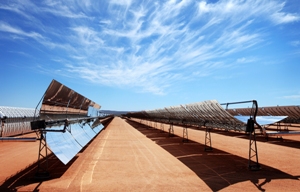Soiling -- the accumulation of dust and sand -- on solar power reflectors and photovoltaic cells is one of the main efficiency drags for solar power plants, capable of reducing reflectivity up to 50 percent in 14 days. Though plants can perform manual cleaning and brushing with deionized water and detergent, this labor-intensive routine significantly raises operating and maintenance costs (O&M), which is reflected in the cost of solar energy for consumers.
 Solar power reflectors collect dust and sand, reducing their energy efficiency—a challenge ORNL researchers are tackling by developing a low-cost, anti-soiling coating.
Solar power reflectors collect dust and sand, reducing their energy efficiency—a challenge ORNL researchers are tackling by developing a low-cost, anti-soiling coating.
Under the sponsorship of the Department of Energy’s Energy Efficiency and Renewable Energy SunShot Concentrating Solar Power Program, Oak Ridge National Laboratory is developing a low-cost, transparent, anti-soiling (or self-cleaning) coating for solar reflectors to optimize energy efficiency while lowering O&M costs and avoiding negative environmental impacts.
The coating—which is being designed by members of the Energy and Transportation Science Division, including Scott Hunter, Bart Smith, George Polyzos, and Daniel Schaeffer—is based on a superhydrophobic coating technology developed at ORNL that has been shown to effectively repel water, viscous liquids, and most solid particles. Unlike other superhydrophobic approaches that employ high-cost vacuum deposition and chemical etching to nano-engineer desired surfaces, ORNL’s coatings are deposited by conventional painting and spraying methods using a mixture of organics and particles. In addition to being low-cost, these methods can be deployed easily in the field during repairs and retro-fitting.
There are, however, challenges to the successful development of such a transparent, anti-soiling coating. First, the coating must be very superhydrophobic to minimize the need for occasional cleaning, and it must have minimal (or even zero) effect on the transmission and scattering of solar radiation between the wavelengths of 250 to 3,000 nm. To meet these requirements, the coating must be no more than a few hundred nanometers thick, and the embedded particles must be considerably smaller. The extremely thin coating must also be durable under environmental exposure, including UV radiation and sand erosion, and be compliant according to the US Environmental Protection Agency Clean Air Act emission standards—which limits the selection and combination of particles and organics that can be used effectively.
During the first year of this project, researchers experimented with a variety of Clean Air Act–compliant organics and silica particles of different sizes. They arrived at a particular formulation combining organic compounds with silica particles, which are dispersed in two sizes to enhance area coverage of particles within the coating.
The anti-soiling coating exhibited excellent superhydrophobic properties, losing less than 0.3% of transparency over the entire solar radiation wavelength range. When exposed to several hundred hours of accelerated UV radiation and one hundred hours of salt fog exposure, the coating exhibited no degradation in superhydrophobic or optical transmission properties. Also, when glass slides with the anti-soiling coating were exposed to sand and dust in a custom-made wind tunnel, the particles did not adhere to the coated surface of the slides—showing great potential for its use in harsh environmental conditions.
In addition to anti-soiling coating for solar applications, ORNL researchers are using their superhydrophobicity expertise to develop anti-soiling cool roof coatings, as well as anti-icing and anti-condensation coatings for air conditioning and evaporative cooling applications, respectively. Going into 2014, the project has been funded for another year and will optimize the coating and perform accelerated exposure tests, as well as begin development on a scalable coating technique and perform small-scale field testing.—Katie Elyce Jones